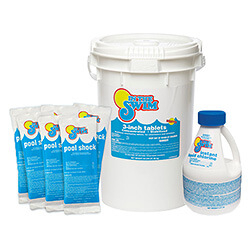
First, let me put two misconceptions to rest. Chlorine for aboveground pools is the same as chlorine for in-ground pools and there is no one best chlorine for a particular pool type.
However, there are many types of chlorine, so let’s determine what type of chlorine is best for you. Some of the choice comes down to preference. Starting out, though, let’s get to the basics of what chlorine types are available.
Pool chlorine can be either stabilized or unstabilized. When many pool owners hear that their chlorine is unstabilized it conjures up images of beakers exploding in laboratories. With chlorine, however, this refers to the addition of a chemical called cyanuric acid to the chlorine. CYA shields the Cl2 molecule from the sun, sort of like sunscreen, stabilizing your chlorine.
The first question should be: Is your pool indoors or outdoors? Indoor pools don’t really need stabilized chlorine, and neither do portable spas. For this reason, and the greater stability at fluctuating pH levels, these types may benefit from using bromine, a close cousin to chlorine.
Types of Stabilized Pool Chlorine
1-inch tablets, 3-inch tablets and slow-dissolving sticks are the exact same chemical compound (Trichloro-S-Triazinetrione). So whether you call it a tablet, a puck or a stick you are getting the exact same product. If you have an outdoor pool you need the stabilized chlorine and per pound, the 3-inch chlorine tablets are the cheapest. Additionally, if you are using a chlorine feeder most are designed for the 3-inch chlorine tablets. To get the most chlorine in your feeder at one time use the 3-inch tablets.
Why would you use the 1-inch tablets or chlorine sticks? This comes down to surface area; when you place the 1-inch tablets or sticks in your feeder they don’t line up as smoothly as the 3-inch tablets do. This gives more surface area for water to erode the tablets, thus increasing the chlorine level more quickly. One-inch tablets are used to chlorinate spas or very small pools, for which a 3-inch chlorine tablet may be too large. One-inch tablets also are great for very large pools, because of the faster dissolution rate.
The other form of stabilized chlorine is di-chlor pool shock. Our Di-Zap granular has stabilizer in the chemical compound (SodiumDichloro-S-Triazinetrione). Stabilized chlorine shock or granular should have 56 percent available chlorine, compared with non-stabilized cal-hypo pool shock, which has 65% or 73%. What it lacks in potency it makes up by having virtually no effect on your pool water’s pH level.
Types of Non-Stabilized Pool Chlorine
Liquid chlorine (sodium hypochlorite), popular in many parts of the country, has some complications in its use.
- It is only 10-15 percent available chlorine and has more sodium than chlorine.
- It is the fastest acting due to the fact that it is pre-dissolved.
- It is unstabilized or unprotected against the sun’s UV rays.
- It requires a specialized feeder or the pool owner to pour it into the pool.
- Pouring it directly into the pool will create peaks and valleys of chlorination.
- Increases pH Levels dramatically, with a pH level of 13.
- Its shelf life is rather short; within six to 12 months it can degrade by up to 50%.
Pool shock can also come in other granular forms that are not stabilized, such as calcium hypochlorite. Cal Hypo, as it’s called, has a higher level of available chlorine, at 65%, but is not stabilized, or protected from the sun. Non-chlorine shock, usually potassium monopersulfate, is unstabilized because it’s, well … non-chlorine or chlorine-free.
All pool shock granular products should be used for superchlorination and not as an everyday chlorinating method. The burn rate is fast, and your pool will soon be hungry for more.
One thing all chlorine types have in common is that when they dissolve in water, they produce hypochlorous acid, which is the active ingredient in chlorine. Without it, contaminants, organic matter, viruses and pathogens begin to grow in any untreated body of water.
Keep in mind the following safety information about pool chlorine:
- Never mix different chlorine types together. They will react violently.
- Follow all label instructions when transporting, storing and using chlorine.
- Never allow dirt or any foreign substance or debris to contact chlorine.
- Keep chlorine in a cool, dry location, away from children.
- Never allow any other pool chemical to come in contact with chlorine.
So, to the question “What type of chlorine is right for me?”, consider your pool size and location. Buy the best chlorine at the lowest price, look for a low-cost stick or tablet, from a company you like, and you’ll be fine.
Enjoy your pool!

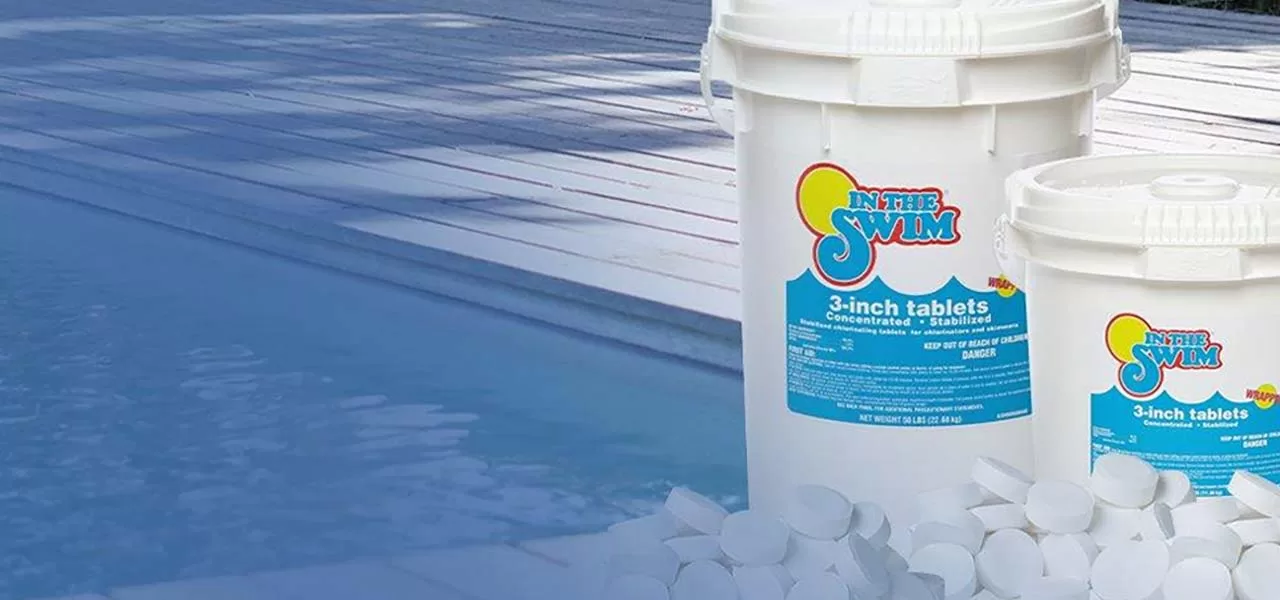





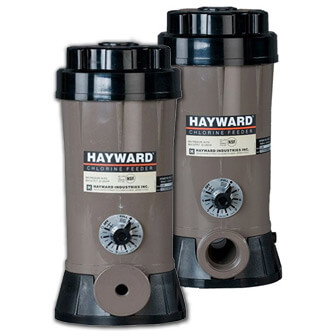
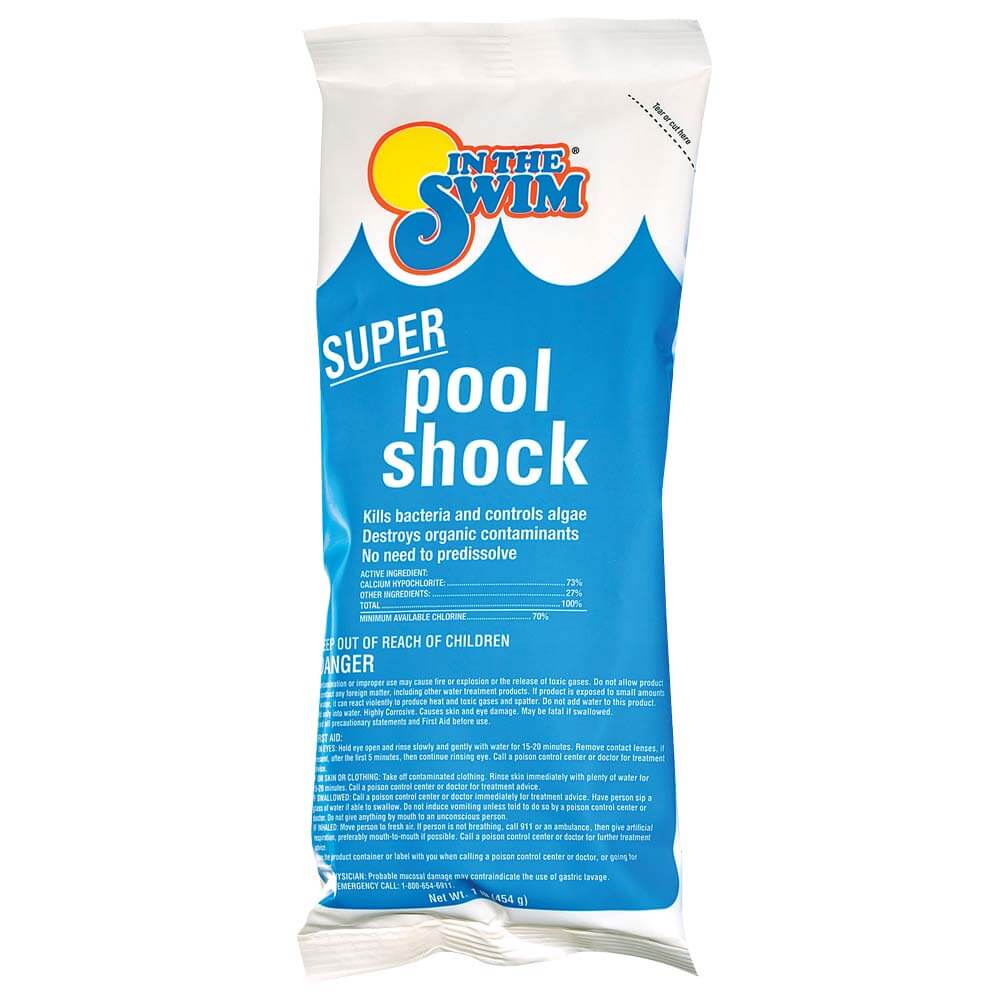



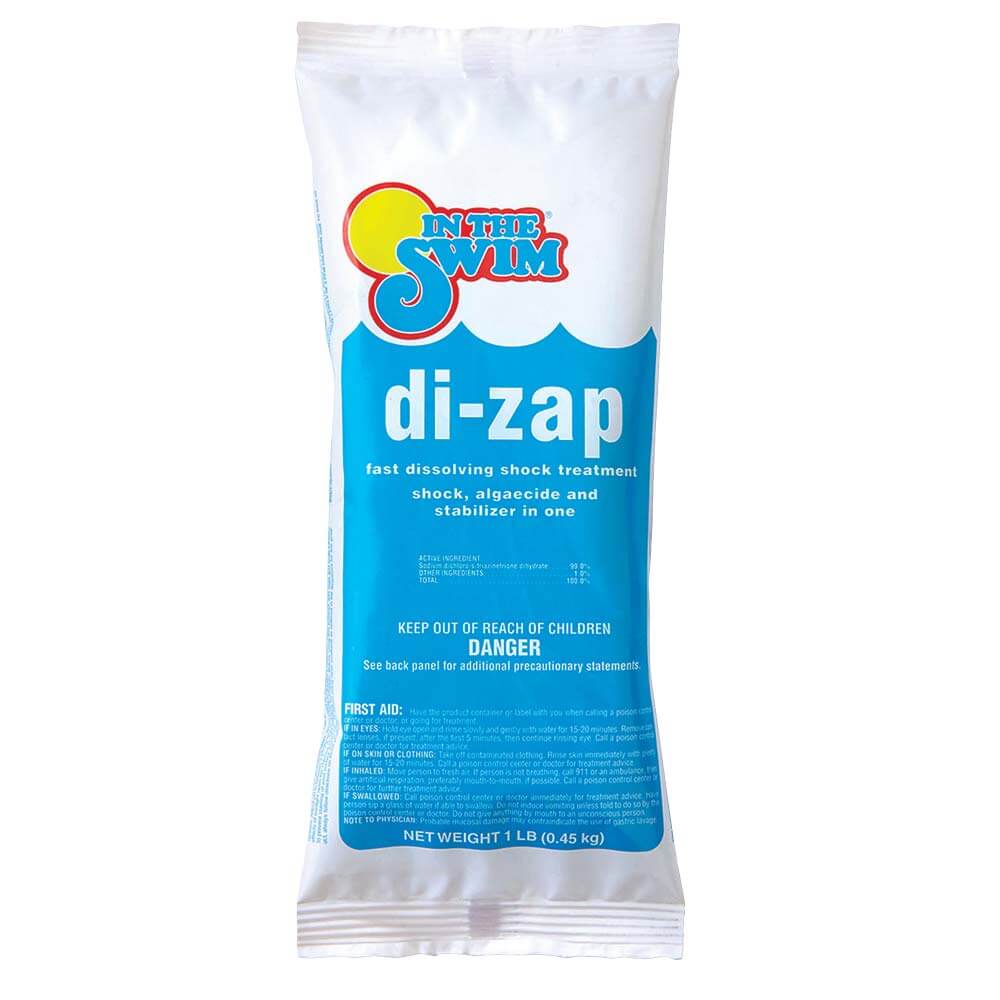
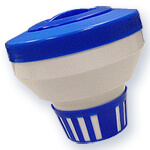
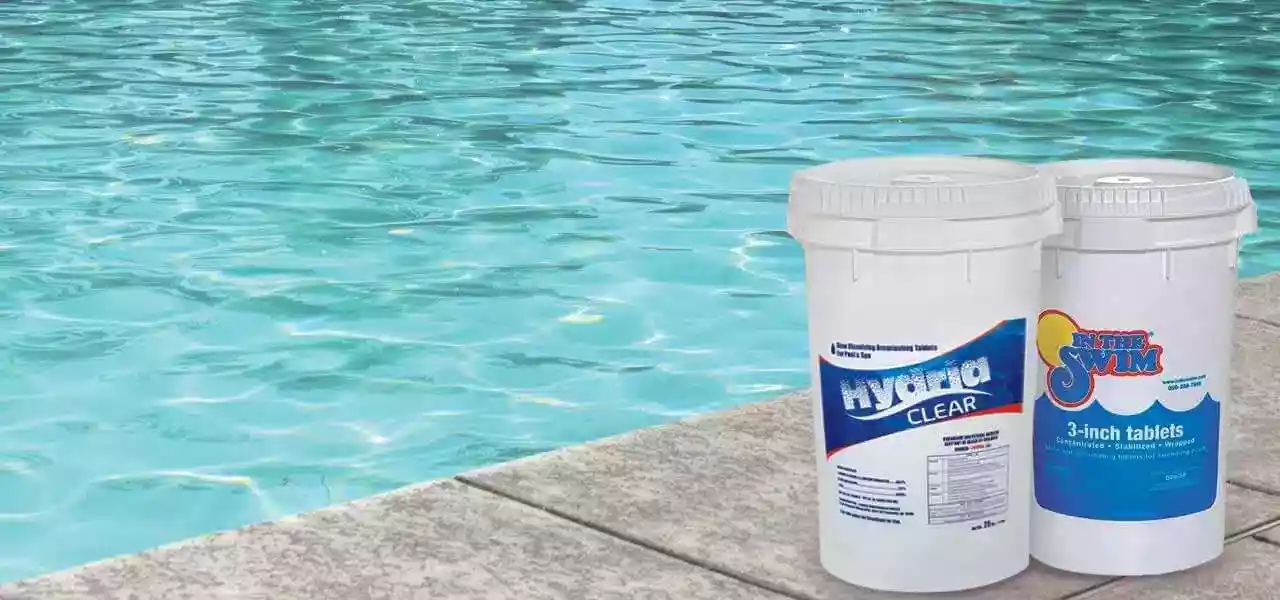
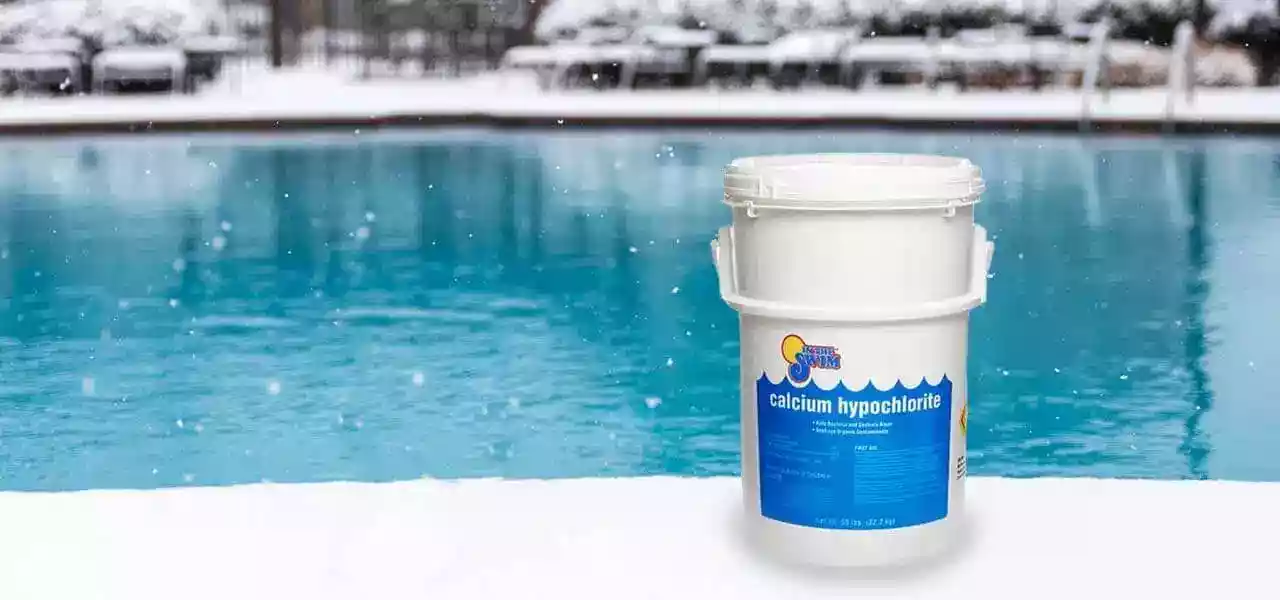
Hi,
Thank for your great article. I have some questions.
Does the pool shock products increase the calcium level in the pool (calcium hypochlorite)? I have a tile pool and would like to minimize the calcium deposit on my tiles. What would you recommend?
Also what do you think of non-chlorine pool shocks that are oxy based (potassium peroxymonosulfate)? Are they as effective as chlorine based shocks? Do they affect the PH?
Thank you so much.
Hi, Cal Hypo shock will add calcium to the pool, small amounts but it will raise the level by a few ppm for every pound added. Non-chlorine shock, is a good substitute, it won’t affect pH level and adds no calcium or cyanuric. It also dissolves instantly and leaves no residue. It is an effective oxidizer, the only downside is it is not as effective as chlorine shock for killing algae, otherwise a great shock to use.
Hi! I recently bought a small pool about 10’ wide by 4’ tall and it doesn’t have a filter. Can I use any type of stabilized chlorine for it? I read somewhere else that I should use chlorine AND a flocculant (sp?) type cleaner. Just making sure that there isn’t a special type of chlorine for non filtered pools?
Use one 3″ tablet, or a couple of 1″ tabs in a floater for daily chlorine dosing, constant and consistent. Then use bleach or granular chlorine, for weekly shock treatment, use about 8 oz of liquid, or 4 oz of granular. Maintain a good pH level, in the 7.0-7.6 range. Take a look at our recent post about maintaining inflatable pools (without filters) https://blog.intheswim.com/how-to-maintain-an-inflatable-kiddie-pool/
Hi there, I am a first time pool owner. We bought a fixer upper house and had to resurface the pool ( plaster). It is approx. 17,000 gallons. I’ve had a pool service while the plaster cures, and want to get ready to maintain myself. We have a Hayward pump with chlorinator. The pool service seems to use ph decreaser almost every week and adds 2-3 tablets per week as well as shock. Oh rubs between 7.2 and 7.8. TA is 120. Hardness is about 300-400. CA is 70-80. The water is clear and chlorine levels per the service are at 5ppm. We only run the pump 7 hours per day. We live in Florida. What are the standard chemicals I will need to have on hand besides 3” tablets. Should the shock be without stabilizer?
yes, use regular shock , without stabilizer, the Cal Hypo. You will also need pH decreaser, and alkalinity increaser. Perhaps also clarifier and algaecide, if needed.
Which chlorine is best if I have to fill the pool with a well? The well is treated with salt and potassium. Right now the pool is very cloudy, after shocking it constantly there is no change.
Chlorine is chlorine, that is — all chlorine types produce hypochlorous acid, so in that regard there is no difference, (despite the title of this post). If your chlorine level and pH level are good, I would look at your filtration. Run the filter 24/7 until this clears up, and look closely at the possibility of a filter problem, or the need to replace the filter sand or cartridge.
Hi Davy,
I have an approximately 15K gallon in-ground pool in Las Vegas, Nevada. I usually float six 3″ tabs in the summer and shock about once a week. Unfortunately, I constantly battle green algae. I also add a product called Perfect Weekly sold at Leslie’s. I also have three beagles that never jump in the pool but I heard that their shedding hair is what feeds the algae. Please help! Lastly, is it better to shock at dusk (I was told that the full Sun dissipates the shock too quickly)
Dom, I would suspect a phosphate issue, treat the pool with PhosFree, and test with the phosphate test strip, to get phosphate levels down to 200 ppm or less. Dogs can contribute to phospate problems, especially if they like to roll around in the dirt! It is better to shock at night, or whenever the direct sun is not on the pool. Also best to have a lower pH level (7.2-ish) when shocking, where chlorine is most potent.
This is my first time owning a pool. Just bought a 10’ above ground pool with approx. 1075 gallons of water. My question is, should I use a 1” or 3” tablet for my floater and if the latter, how fast will it dissolve in the pool? I purchased chlorinating tablets, as well as “Clear Balance” for the pool. I am at a complete loss on how to go about setting up this pool with the correct chemicals and keeping it safe for the kids.
Hi Kayte, just focus on keeping a good chlorine level and a good pH level, and don’t worry so much about all the other water chemistry stuff we talk about. That will come with time. You can use 1″ or 3″ tablets. I would guess one 3″ tablet at a time, with the vents almost closed, replaced promptly when the tab is almost fully dissolved. “Use enough tablets to produce a consistent 1-2 ppm level”. Meaning, if your chlorine tests are too high, maybe use 1/2 a 3-inch tablet at a time, and if chlorine is too low, open the vents more on the floater base, or add another tablet to the floater. Smaller 1″ tabs do dissolve faster, due to increased surface area, but should not be needed. Secondly, use an acid to lower pH level if it gets 7.8 or higher, just a small amount like 1/4 cup at a time, and retest. Best pH range is 7.2-7.6.
I have a 13,000 gallon pool that I’m looking to start up from scratch. I was researching the best chlorine for use in South Louisiana with full sun exposure. I’ve read many posts and hope to get some advice.
He have well water which has a PH of roughly 8.3 and strong buffering capacity when I had a salt water aquarium. A near by municipal well that is treated by the city for drinking water supply for the city has 135 ppm of total alkalinity.
I know we have high metal content. I also am not opposed to using a liquid to get started before going to a stablizied chlorine or non-stabilized with CYA added separately.
Jeremy, make it easy on yourself and just use 3″ stabilized trichlor tablets. It has a low pH which will help drive your pH and alkalinity down, and is already stabilized.
What is the beat way to open pool when I have a lot of leaves and debris in bottom of pool.I tried vacuuming,but have cartilage and they keep getting clogged and I have to keep changing and cleaning filters.Is there any way I can suck out debris by bypassing filter.
Hi Henry, if you have a bag type pool Leaf Rake, running it slowly across the floor of the pool allows you to scoop up the leaves, leaf rake techniques explained here. Spend an hour or so doing that before vacuuming, and your vacuuming will be less frustrating. For cartridge filters, you cannot vacuum to waste, like you can with a sand or DE filter, unless you install a 3-way valve in-between the pump and filter, and connect a waste pipe or backwash hose. Another way is to make a Porto-Vac out of an old pool pump.
You said “All pool shock granular products should be used for superchlorination and not as an every day chlorinating method. The burn rate is very fast, and your pool is soon hungry for more.”
I really don’t see why this would be the case. I have my CYA finely tuned to 60ppm and stabilized chlorine would throw that off. CalHypo goes for only $4.10/lb of FC ($150 for 50lbs of 73%). The only down side is that I have to add some every day to maintain the recommend 8ppm FC. Would be great if there were unstabilized slow-release tablets.
Hi Nolan, you seemed to answer your own question. The downside is that you have to add granular nearly every day, because it dissolves so rapidly, as opposed to tablets which can last for week(s). BTW, the recommended ratio of CYA to chlorine is now generally agreed to be 20:1, so if you have 60 ppm CYA, you should be safe with a 3 ppm chlorine level. Cal Hypo tablets can be used, but always/only must be used with a Cal Hypo feeder, which wets only one tablet at a time, because they dissolve quickly when in contact with water.
Thanks for the info Davy!
We have an intex 3500 gallon pool. Our tabs weren’t dissolving well… don’t know why. Pool store said never buy chemicals from a non pool store. We switched to granuals, but I see you are saying the tabs should really work just fine. We also don’t normally do anything with ph/alk. Does that matter??
Hi – ph/alk are important, but you may (?) be fine there. It’s more of a problem if either is very high. If the tablets are not dissolving well… I’m not sure what that means, not fast enough? You could add more, or open up the baffles more on the chlorine floater. You may need a level of cyanuric acid (chlorine stabilizer) in the water, the sun may be burning off the chlorine nearly as fast as it is being added. Just 1 lb of stabilizer would do it.
Hi, I have an above ground pool about 10,500 gallons vinyl liner. I have been using Chloro-brite 1 lb of Granular Chlorine Pool Shock says sanitizer on it, we have algae issues all the time. I was told that it could be holding it in and can block the chlorine? I don’t know what to use, I was told no tablets, so confused. Use only this, don’t use this, use liquid, don’t use liquid it will destroy your liner……PLEASE HELP
Hi, the algae problem is likely a result of less than consistent chlorination (peaks and valleys), possible high pH, and maybe less than enough filtration, or a small and somewhat tired filter (?). What you need is actually two types of chlorine, tablets are best for daily sanitation, to provide a constant and consistent level of 1-2 ppm, and you also need a shock treatment, liquid or granular, to raise the chlorine level to over 10 ppm weekly, to kill anything that the daily chlorination missed, or to kill algae that is visible again, or correct cloudy water, or can be used to boost chlorine quickly, if the tablets ran out and was forgotten about, or if power outages shut off the pump for awhile, or for heavy rainstorms, heavy pool use, etc. Pool pH level is the next most important thing, should be in the range of 7.2-7.6 for best results. Liquid can be used as a shock treatment, or as a daily chlorination too – IF you have a $400 chemical pump, to deliver it one ounce at a time, all day long, or poured in manually 2-3 x per day. Tablets in a floater or chlorinator is so much simpler, just add enough to give a consistent 1-2 ppm reading, which is probably 2-3 tablets, replaced weekly or when they dissolve away.
I live in the NE, (PA), and have a 13 year old, 30,000 gal, vinyl pool. My problem is the steps, (I’m not sure if the pool steps are fiberglass or some type of plastic). The steps have a large number of cracks around the outside edge. Under the water line there are blisters on the surface, and on the treads there are a large number of brown spots that look like brown splinters. These also have cracks. For the last 5 years I have been using liquid chlorine for the daily chlorination and hypo for shock. I have been using the “Poolcalculator.com” for my chemistry advice and keep the chlorine level between 3 and 7 ppm. I know there’s controversy in regards to these levels. but they convinced me to use them. I keep the chemistry right on and the water is always perfectly balanced. I use muratic acid to keep the PH levels down since the liquid chlorine tends to keep raising the levels. Could there possibly be a connection between the use of liquid chlorine and chlorine levels, and the step problem? Any advice would be greaty appreciated.
Hi Lloyd, Fiberglass steps can blister, when gas is trapped under the surface. Fiberglass can also crack, with heavy weight (people) on the steps, especially when not installed completely supported underneath with backfill. And minerals like iron can stain cracks in the step gelcoat covering. You could try using a Stain & Scale chemical to reduce the brown stains, and possibly remove them. A+ Stain Remover or the Stain Eraser may also be the ticket for the brown stains. I don’t think it’s your chemistry or chlorine type, but maybe – possibly, the high level of chlorine could be contributing to weakened steps. Replacing those steps is no easy feat, but could be done, perhaps the next time you replace the liner, probably add about $2K to the cost.
My CYA is at 100. It was at 200 last summer, i was advised to drain a little and refill 4 times. My CYA seems to be going up again and I have now realized that I am using Trichloro shock granules and Tricholor pucks, which I believe is the culprit of my continuing CYA high levels. However my pool is not growing any algae. All of my levels are off, aside from fully draining my above ground 14,000 gallon pool, what else can I do? Would more partial draining and using non stabilized chlorine help?
Hi yes, more draining, if possible drain half of the pool, by plugging the skimmer (or closing valve) and pulling from main drain(s) only. Then refill with fresh, which should reduce cya by half. Switching to Cal Hypo pool shock would help reduce the build-up. Here is a blog on cyanuric acid for more information. Adding a mineral purifier, like nature2 or pool frog, is a good way to reduce cya build-up also, or switching to a saltwater system.
We have a above ground pool that needs to be taken down each year, 16’ X 48”. We have well water and need to use a metal removing agent. We have done so and added chlorine 2 days later. I checked the chlorine level every day and have a stablizer so my cya level is right where it should be and so was the chlorine that morning my water still turned green by mid afternoon. I shocked it but now it has turned I think brown again, hard to tell if it is green or brown at this point but the filter it rusty looking when I rinse 4 times a day! Is there a certain kind of chlorine I can use that will not turn the water brown but still kill algae? I have drained the pool twice now and am about ready to throw it away! This time I did not drain. I added a bottle of algacide and shocked it 2 days again and not sure Iv’e made any progress. Im afraid to shock again with what I have as I don’t want to make the brown worse but need to kill the algae.
Hi Janet, brown sounds like metals, green could be too. When shocking the pool, that can break apart the metal agent, and to really keep the metals locked up in solution, pools need to have the maintenance dose, because the chemical depletes over a week or two. Since the filter is trapping rusty looking debris… needs more Metal Control agent, and after shocking – after the chlorine level drops, it needs more again. 4 times per day rinsing? That’s a lot of work, a bigger filter sure would save you a lot of time!
We did just buy a new pump for the pool. The pool store said it would help filter the pool faster but it has been running for 2 days now and it look about the same, maybe a little better. I was unaware I needed to keep putting in the metal control agent. I thought once you took care of it you were good unless adding more water. So if I understood you correctly I should put some in now and again the next time I shock? What is the maint dose, Every week or every time I need to add regular chlorine? This $300 pool is turning into the million dollar pool!
Hi Janet, that’s right – sequestering agents (Stain & Scale chemicals) only last for a week or two, and are degraded by the sun, just like chlorine. Read the bottle label, it will have precise instructions on the Initial Dose and the Maintenance Dose, it may be every week, or every other week, varies by brand. The maintenance dose is usually quite small, compared to the initial dose.
We have a vinyl pool (19000 gallons) that consistently shows low free chlorine no matter how often we shock (up to 3 times per week), type of shock, or how long we run the pump (14 to 24 hours/day). We are also using a chlorine feeder (on max) and a floating dispenser and nothing brings chlorine up for more than a couple of hours. The pool is a UV with DE filtering and water looks amazing. Again, we just can’t seem to get the chlorine levels up to acceptable range. Any thoughts on what we are missing or need to do?
Hi Ron, you didn’t mention cyanuric acid (stabilizer), 30-50 ppm is recommended to protect chlorine from the sun. And pH? For the highest chlorine activity, lower is better, 7.2 – 7.4, chlorine is very sluggish at higher pH, (but should still show a test result). Phosphates or nitrates could be a problem, Pool First Aid or Phosfree can be used if phosphate tests over 300 ppb. Generally the first thing to try in such cases as yours is to triple shock with chlorine (3 lbs per 10K gals) to reach a breakpoint threshold of 30 ppm, where everything is oxidized, even those invisible compounds that consume the chlorine.
can you use NST tablets in an inline chlorinator?
or are they strictly for use in skimmers?
Hi Dennis, NST tablets, by Arch without any cyanuric acid, are meant to be used in the skimmer. From the manuf “Use only in pools with a skimmer and skimmer basket. Skimmer basket must be free of all other water treatment products before adding this product.” Don’t put them in a chlorine feeder, it will gunk it up or something…?
Hello, I am wanting to change the type of chlorine in my pool from a stabilized chlorine to an unstablized chlorine. What is the safest way to do this?
Hi Mickey, good question. The first thing that comes to mind is to install a saltwater chlorine generator and ‘go saltwater’. Secondly, you can install a Cal Hypo tablet feeder, like the CCH Feeder, which uses a specific Cal Hypo tablet, without any cyanuric acid. A third way would be to purchase bleach from a local Sodium Hypochlorite supplier in 5-gal containers, and use a chemical pump, like the Blue-White or RolaChem, to pump from the container, directly into the pool line, a 12.5% bleach solution (without cyanuric acid). A fourth way to do it would be to reduce the need for chlorine, by installing a large DE filter, Nature2 Express, and/or an Ozonator – then just shock the pool weekly, with chlorine or non-chlorine shock, (or use 1/3 as many tablets, which reduces the buildup of cyanuric). With exception to the last method, you will need to add a few pounds of cyanuric every so often to keep levels at 20-30 ppm, but it won’t add any to the water.
Dear sir.hi I have an issue with my pool.CYA amount in my pool is 120 ppm.to Lower the ppm below 100 I am to only use shock and stay away from chlorine tabes.my pool is 12000gal.outdoor, and I live in Arizona, Hot.Hot
Thank you Henry
Hi Henry, to reduce cyanuric acid levels, the solution is dilution, drain and refill a portion of the pool to lower cya levels. You can also use Bio-Active, an new product that claims to reduce cya by up to 50 ppm, for a $50 cost.
We have a large above ground outdoor pool. We are used to using chlorine granules from our previous intex pool. That pool did not have a sand filter. This new pool does. Can we use granules with a sand filter?
Hi, sure you can, the filter doesn’t change any usage of pool chemicals. Best practice is to pour the granules into a 5-gal bucket filled with water, stir for a minute to dissolve, then pour around the edge of the pool, with the pump running to help circulate. If any stray granules fall in, sweep them around with the pool brush.
My CYA is 70PPM can I just use the shock to maintain my pool if the CYA stays at this level, I am on a private well and don’t want to have to drain and replace if I don’t have to. Chlorine is the most confusing thing all of the other chemicals are pretty straight forward.
Hi Michael, you can use pool shock to treat your pool, regular cal hypo shock has no stabilizer. It will be quite inconvenient however, to have to add it so often, so that you don’t create peaks and valleys of chlorination (very high, then very low). If you buy a new chlorine floater (don’t use one previously used for tablets), you can add a lb of shock, and close the vent holes and it will distribute for a few days. Don’t do this on a vinyl pool, as it will damage the liner. Also must be handled carefully, and removed gently before using the pool. If you are able to add pool shock once or twice per day, you can also treat the pool by adding shock twice per day. Try to avoid leaving opened bags of shock around, it could create a safety hazard. If your pool is big enough, use the whole bag, or if not, dilute the entire bag into a very clean bucket of water, or other pour (carefully) into a very clean gallon milk jug, filled full of water (before adding shock). Then you can use the ‘liquid shock’ for a few days, adding a cup or two at a time (wearing safety goggles, gloves and old clothes!)
Thanks! That makes sense. One thing: per Pinch-a-penny, I’ve always used muratic acid to maintain the pH with the salt system. Is that still an option for a chlorine pool, or should I use special pH up/down products instead?
Hi, they are the same thing, one is liquid and one is granular, you can use either to control pH. However, tablet chlorine has a lower pH value than salt generated chlorine, and much lower than bleach, so you will likely find that you don’t need to lower the pH as much, when using tablets. Or, you may find that you need to start using pH Up, or soda ash. Give it some time, and you’ll find out.
My salt cell recently stopped working – the salt system is 8 years old – and I can’t afford to replace it right now so I want to run the pool as a chlorine pool. I’ve been adding liquid chlorine from the pool store and would like to know if there is a more cost effective option, i.e. liquid chlorine from somewhere else or chlorine tablets. I’d also like to know what else I need to add to the pool.
The pool is 11,700 gallons and I live in Florida and it’s been very dry and hot lately.
Hi Sandy,
The salt system could be expensive to replace, so I understand. You can replace the salt system with bleach (liquid chlorine) administered once or twice per day, but this tends to create peaks and valleys in chlorination, unless you have a chlorine pump, which cost about $400, so the next best way is to use trichlor tablets (or sticks, same thing). Buy a floater, aka floating chlorinator and fill it up with 3 or 4 of the 3″ tablets, and when they dissolve, add 3 or 4 more. Use enough tablets to test a consistent 1-2 ppm, at all times of the day and season. You can also install a larger tablet chlorinator into the plumbing system, after the pump and filter, for greater control.
In addition to maintaining a constant and consistent chlorine level of 1-2 ppm, you also should make sure that your pH level does not go above 7.6, or below 7.2. Most pools gravitate either up or down, so you need to have some pH adjustment chemicals (ph up and ph down) to keep those good. Beyond that, you also want to check and maintain 3 other chemical levels, total alkalinity, calcium hardness and cyanuric acid (stabilizer) levels. But these three are more slow to move, pH and chlorine are fast to change, so need to be checked more often, a few times a week. the other 3 can be checked every month or two, and adjusted if needed.
For the yellow algae – uh oh! After balancing the water, with a low-ish pH level of 7.2-7.4, shock the pool with 5 gallons of bleach or 5 lbs of shock. Brush the pool hard, add some clarifier, and when the water is clear, replace your filter media (DE grids, sand or cartridge), or at least soak grids/cartridges in a 10:1 water/bleach solution, to kill any traces of yellow algae, which likes to harbor deep in pool filters.
We need a new pool liner. The pool people said ours deteriorated faster beacuse of poor chemical balance. They recommend unstabilized chlorine and a Chlorine dispenser. What is your thought about this?
Hi, it is true that certain chemical issues can pull the resilience out of a liner, by removing plasticizers and making the vinyl brittle. A low pH / low alkalinity environment is quite harsh on the pool, and low calcium levels also are not good. High chlorine levels, consistently, with heavy shocking too, is also very harsh on vinyl. He may be recommending unstabilized chlorine because Trichlor tablets are low in pH, and may require occasional pH correction, to keep pH from getting too low. A chlorine feeder or dispenser is a good idea, to avoid peaks and valleys in chlorination, and protect the liner. However, I think regular Trichlor tablets are fine, used in a floater or chlorinator, you just have to check your pH every week, and have some pH Increaser on hand to raise the pH a little bit once per month.
A friend recommended that I keep tabs floating in a floater and ALSO use granules. I shock weekly as well. Is this over kill?
It could be overkill, but it depends. The 5 reasons for shocking are 1). to remove organic bacteria and pathogens not killed by the tablets, or 2) to remove chloramines, or 3) to remove algae, or 4) if the water is cloudy or 5) if you forget to put tablets, or dont’ put enough for a hot day. If your water always looks beautiful, and you consistently and constantly have a 1-3 ppm tested chlorine level from your tablets, and your pool filter is not undersized or limping along, and if your pool usage is low to average – you can probably shock once per month. But If you have a poor filter, or only run the pump 8hrs per day, or aren’t vigilant in your daily chlorine level and pH levels, or if you notice algae, cloudy or dull water – then you may need to shock weekly. But if everything looks great, you can shock 1-2x per month. And, you probably don’t need to add granules AND tablets for daily chlorination, just enough tablets to register a consistent 1-3 ppm reading. Too Low? Add another tablet. Too High? Remove 1 or 2 tablets …
excellent, straight forward answers for a new pool owner. thank you Brett.